S uch was Francis Cadell presence that commentators struggle to separate the personality from the painter. Cadell’s friend and fellow artist Stanley Cursiter is typical in declaring that ‘no appreciation of his art is adequate without a note on the man’. In an expressive portrait produced for the introduction to Cadell’s memorial exhibition, Cursiter continues,

He was of middle height and robust build, he walked with a certain jauntiness of step – a straight and serviceable pipe gripped firmly in his teeth, an eye that lifted to a twinkle and a smile ready to expand to a quick laugh; careful in dress but seldom without a gay, distinctive note – shepherd tartan trousers – a blue scarf – a yellow waistcoat – or all the glory of his kilt, but with all, an air! ... His wit was constant and brilliant…it was but an indication of many-sided accomplishment which found expression in colour, in verse and life itself.
As the youngest of the select group known as the ‘Scottish Colourists’ – a lively group of the early twentieth century united by their preference for vivid colour and fluid handling of paint – Cadell stands out for his energetic charisma and eccentric dandyism. Never taking himself seriously enough to develop a reputation for being intellectual or political, Cadell entertained and enchanted whomever he met, whether Hebridean islanders or Edinburgh’s upper classes – revelling in playing host to the latter group at his career’s height in the 1920s. Taking great pains over the decoration and fashionable furnishing of his home and studios, Cadell forged firm friendships through his work, and was unusual for the high number of paintings he sold directly to patrons. The highly accomplished work Reflection which achieved Cadell’s sale record in 2018 (Sotheby’s London 12 June 2018 lot 119, £874,000), offers a beguiling glimpse into this glamorous world.
At times Cadell’s relentless sociability could come across as inscrutable: ‘He so enjoyed the art of living’, writes Tom Honeyman, an influential early supporter of the Colourists, ‘that he cared less for the job of picture making … Perhaps it was part of his fun to make us think so’ (quoted in R. Billcliffe, F.C.B. Cadell 1883-1937: A Centenary Exhibition, The Fine Art Society, 1983). But to be taken in wholly by the forceful personality of ‘Bunty’ – as Cadell was known to friends – does an injustice to his dexterity as an artist and his work’s wider significance. Far from ‘caring less’ for picture making, Cadell’s bold brushstrokes, clarity of composition and consummate use of colour mark him as a remarkable painter, whose work did much to earn Scottish art a position at the vanguard of the modern European movement.

Cadell’s early aptitude for art had been encouraged by his family, and in 1899, aged sixteen, he quit Edinburgh for Paris to study at the Académie Julien. Remaining in the city for the next eight years, Cadell gained exposure to a pioneering body of artists such as the impressionists at the Luxembourg, Bonnard, Vuillard, Matisse and the Fauves, and above all Whistler. Distinguished throughout his career for his extraordinary versatility, Cadell would excel at everything from interiors, to still lifes, to figure studies, to landscapes. This ability to work confidently in a wider range of genres than his older Colourist colleagues is illustrated by the selection of works in the present sale (lots 33, 36, 49, 50, 53).
Upcoming Works by Francis Cadell
One important subset of Cadell’s diverse oeuvre is the series of works inspired by excursions to the island of Iona (see lot 49). Visiting for the first time in 1913 and returning for the next twenty years, Cadell was fascinated by the everchanging colour of the pale sands and shallow waters, the soft greens of the fields contrasted by the reds and browns of the rocks. Becoming a well-liked figure known to the islanders as ‘Himself’ for his idiosyncrasies, Cadell relished painting en plein air. Working quickly over an absorbent white ground which he painted over while still wet, Cadell achieves a quality of light and intensity of colour rarely equalled by the many artists who sought inspiration from the island.
Perhaps the most ground-breaking period of Cadell’s output comprises of his unpeopled interiors and disciplined still lifes of the 1920s. Adopting tightly-cropped compositions to deploy blocks of brilliant, barely modulated colour, Cadell’s still lifes – exemplified by Roses in the present sale (lot 50) – are arguably unique among the Colourists and, indeed, in twentieth-century British art.
Though inexplicably overlooked in the years following his death – perhaps as out of step with movements in his lifetime such as Constructivism and Surrealism – Cadell’s reputation deservedly continues to grow. Viewers cannot fail to be struck by what one contemporary called ‘a gift of colour and light – these seen in a joyous mood’ (Letter from Pittendrigh MacGillivray quoted in F.C.B. Cadell, National Galleries of Scotland, 2011). Here was the man who saw beauty in many forms, blessed with an intense love of life, who strove to convey that beauty to others. Today the colours remain no less dazzling.












